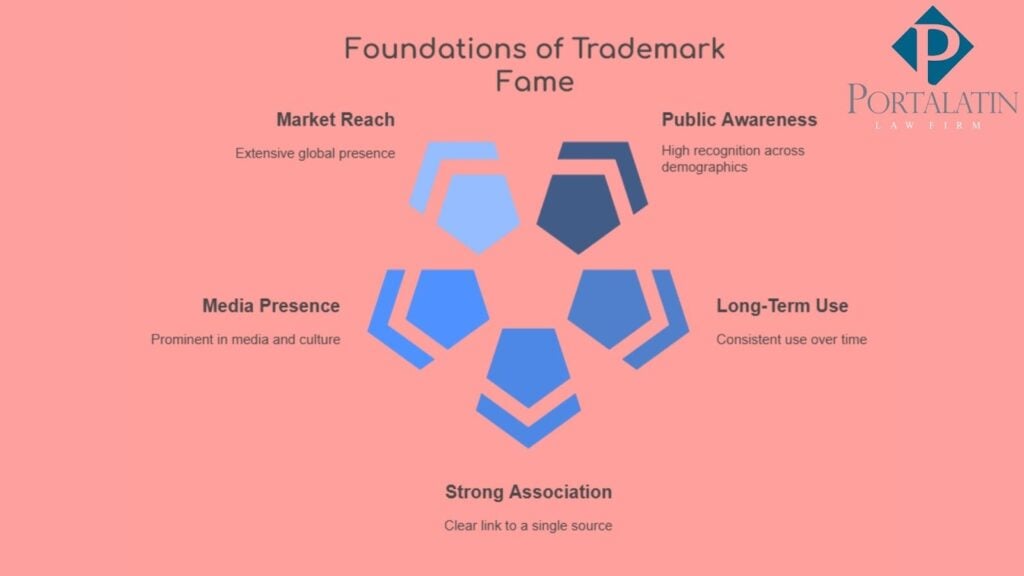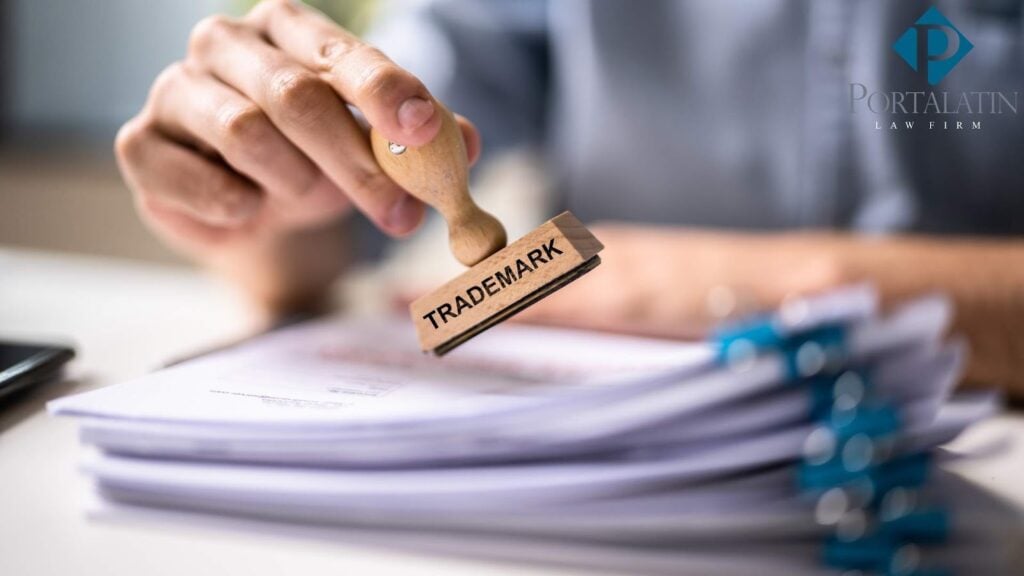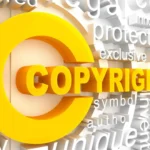Some brand names are instantly recognizable, and that’s no accident.
According to the United States Patent and Trademark Office (USPTO), nearly 770,000 trademark application classes were filed in 2022 alone, reflecting just how many businesses are trying to stand out and protect their identity. But only a few marks ever reach the level of global recognition and legal strength that define famous trademarks.
At Portalatin Business Law Firm, we’ve built our name on trust, standing behind our work, and being honest. We understand that the key to a successful trademark is remaining recognizable and respected over time.
Key Takeaways
- Famous trademarks get stronger legal protection, including against dilution in unrelated industries.
- Brands like Coca-Cola and Apple became iconic through consistency, visibility, and enforcement.
- Dilution laws protect brand identity without needing to prove consumer confusion.
- To build a famous mark, focus on simplicity, consistency, exposure, and legal defense.
What Is a Famous Trademark?
A famous trademark is a brand name, logo, or symbol that’s widely recognized by the general public. People know it instantly, across industries and countries.
Legally, it gets broader protection than regular trademarks. Even if someone uses a similar name in a completely different business, the original brand can take legal action. That’s because the law protects against dilution, when another use weakens the brand’s distinctiveness.
Legal Definition Under U.S. and International Law
Under U.S. law (Lanham Act), a trademark is famous if it’s:
- Widely recognized by the public
- Strongly linked to one source
- Seen often in advertising or media
- Used consistently over time
Other countries use similar tests. The EU looks for “reputation”, while China and India focus on market exposure and local recognition.
How Famous Trademarks Differ from Regular Trademarks
| Feature | Regular Trademark | Famous Trademark |
| Protection scope | Same or similar products | All products and services |
| Proof of confusion | Required | Not required (dilution applies) |
| Public recognition | Industry-specific | General public |
| Examples | Local brand name | Nike, Apple, Coca-Cola |
Why It Matters
Famous trademarks stop copycats fast. They protect brand value across markets. Courts take them seriously, even when the copied use is unrelated.
How Trademarks Become Famous

Trademarks become famous through time, visibility, and proof. Famous trademarks achieve this through consistency, broad exposure, and legal enforcement that keeps the brand intact over time.
What Makes a Trademark Famous
To qualify as famous, a trademark must meet specific criteria:
- High public awareness across age groups and regions
- Long-term use without major changes
- Strong association with one company or source
- Heavy presence in ads, media, or pop culture
- Broad market reach, often global
Legal Recognition Examples
Fame often shows up in court filings, enforcement wins, and global IP databases. Here are some examples:
- Coca-Cola: Courts upheld its fame based on decades of advertising and brand loyalty
- Google: Recognized for dominance in search and brand usage as a verb
- Apple: Known for its consistent branding across tech and media sectors
Top 10 Most Famous Trademarks Worldwide
These trademarks are recognized across languages, borders, and industries. Courts, consumers, and businesses agree, they’re icons.
1. Coca-Cola
Founded in 1886, Coca-Cola is known worldwide for its red-and-white script and iconic bottle shape. It used early mass advertising to stay in front of consumers and kept its design nearly unchanged for over a century. That consistency paid off. Courts have cited it in multiple dilution cases, recognizing the power of its brand identity.
2. Apple
Apple launched in 1976 and dropped its original logo quickly in favor of the minimalist apple with a bite. It’s now a global symbol of tech design and simplicity. From the iPhone to its stores, Apple keeps visuals clean and consistent. Its trademark has held up in hardware and media disputes across multiple countries.
3. Nike
Created in 1964, Nike built its brand around a $35 swoosh and three words: “Just Do It.” It linked itself to athletic identity and emotion, investing heavily in athletes and visual branding. The result is a logo that stands alone, backed by broad legal protection for both the mark and design.
4. McDonald’s
Around since 1940, McDonald’s turned the golden arches into one of the most recognized symbols in the world. Add in Ronald McDonald and Happy Meals, and it became a staple of childhood branding. Its legal team regularly stops restaurants from mimicking its marks, even if they’re in other countries or industries.
5. Google
Google was founded in 1998 and built a brand on clean design and speed. The colorful logo is playful but consistent. Over time, “Google” became a verb, making it one of the few trademarks embedded in everyday language. It’s protected across dozens of service categories and platforms.
6. Amazon
Amazon, which began in 1994, grew from a bookstore to a marketplace empire. Its smile-arrow logo links “A” to “Z” and appears on boxes worldwide. The brand leads in e-commerce recognition and has successfully enforced its trademark against lookalike marketplaces.
7. Microsoft
Established in 1975, Microsoft is a household name in both business and personal tech. The Windows OS and Office suite helped build massive brand awareness. Microsoft’s logo has evolved, but its identity has stayed strong, supported by decades of IP enforcement.
8. Disney
Dating back to 1923, Disney built its trademark empire around imagination. Everything from Mickey Mouse to the castle logo, is branded, protected, and enforced. They’re known for aggressive legal moves to protect even its oldest marks.
9. Facebook (Meta)
Facebook, now Meta, launched in 2004 and became instantly recognizable through its blue “f” icon and social dominance. After rebranding to Meta, it expanded its trademark coverage into VR, AI, and metaverse-related products.
10. Mercedes-Benz
Founded in 1926, Mercedes owns one of the most iconic logos in the automotive world: the three-pointed star. It stands for performance, luxury, and engineering. The brand protects its mark across product classes and countries, maintaining tight control over usage.
Famous Trademarks in Legal Context
Remedies for trademark infringement can include injunctions, monetary damages, and even destruction of infringing products, showing how seriously courts take the protection of famous marks, especially when dilution or harm to reputation is involved.
Dilution and Why It Matters
Trademark dilution happens when another brand uses a similar name or design, even in a completely unrelated business, and weakens the original brand’s uniqueness. Unlike typical trademark cases, there’s no need to prove confusion, just that the new use harms the famous brand’s identity.
There are two main types:
- Blurring: Weakens the mental link between the brand and its product (e.g., “Google” used for unrelated clothing)
- Tarnishment: Damages the brand’s image by linking it to something negative (e.g., an adult site using “Disney” in its name)
Legal Wins That Set the Standard
These cases show how courts give extra weight to brand fame.
- Victoria’s Secret v. Moseley: Established dilution as grounds for blocking a similar-sounding adult store
- Coca-Cola cases: Courts have repeatedly blocked similar bottle shapes and red packaging
- Apple Inc. v. Prepear App: Apple defended the similarity in fruit logos, even in unrelated industries
How Global Laws Handle Fame
Different regions recognize fame differently:
- U.S.: Uses the Lanham Act and federal court rulings
- EU: Recognizes “reputation” under the EU Trademark Regulation
- China: Offers protection after a mark gains “well-known” status locally
- India: Adds extra weight to trademarks with national recognition or long history
5 Ways to Build a Trademark That Becomes Famous

With over 11.6 million trademark applications filed globally in 2024, as per the WIPO, standing out is harder than ever. That’s why simplicity, consistency, and legal protection are necessary from the start. Filing early and enforcing consistently helps brands build recognition that lasts, and keeps imitators out of the picture.
1. Keep It Simple and Unique
The strongest trademarks are:
- Easy to recognize
- Easy to pronounce
- Visually distinct
Made-up words (like “Google” or “Kodak”) tend to perform best. Descriptive names get weak protection and rarely become famous.
2. Stay Consistent Across All Channels
Consistency builds memory. Use the same logo, color scheme, and tone across:
- Product packaging
- Ads
- Websites
- Social media
- Physical stores
Don’t reinvent your visual identity unless absolutely necessary.
3. Invest in Visibility
Fame requires exposure. Famous brands put their mark everywhere, TV, digital, print, merchandise, and sponsorships. You need:
- Broad and repeated use
- High public visibility
- Marketing that ties the brand to a feeling or experience
4. Protect the Mark Legally
File early. Defend often. A famous trademark is only as strong as its legal backbone. Letting small infringements slide weakens your rights over time. Steps to take:
- Register nationally and internationally
- Monitor for similar names or logos
- Enforce against misuse, even in unrelated industries
5. Measure Recognition
You can’t claim fame without data and data is highly valued by courts Use:
- Consumer recognition surveys
- Media mentions
- Market penetration stats
- Search engine visibility reports
Want to Make Your Brand Legally Unstoppable?
The world’s most famous trademarks got protection early. Strong brands don’t just happen through design and marketing, they’re backed by legal strategies that prevent copycats and reduce risk from day one.
At Portalatin Business Law Firm, we help entrepreneurs lock in long-term protection through smart and proactive trademark services. If you’re serious about protecting your brand and setting it up for real growth, start here. We make the process clear, accessible, and built for the future.


